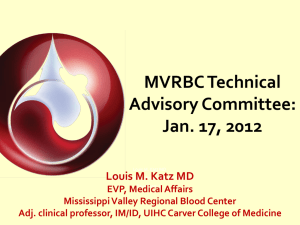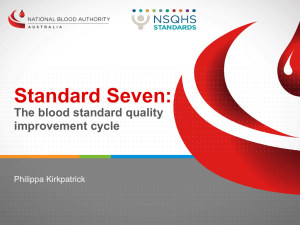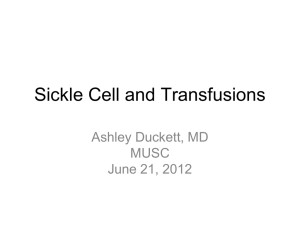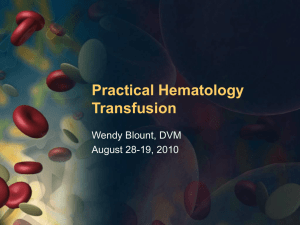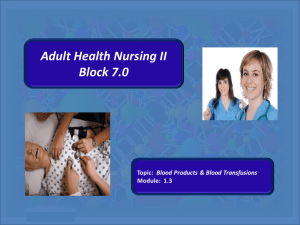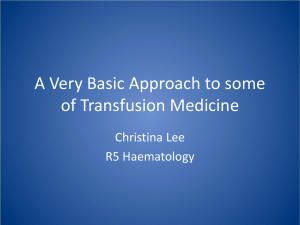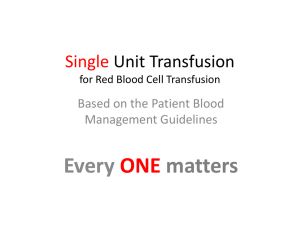blood transfusion and transfusion reaction
advertisement
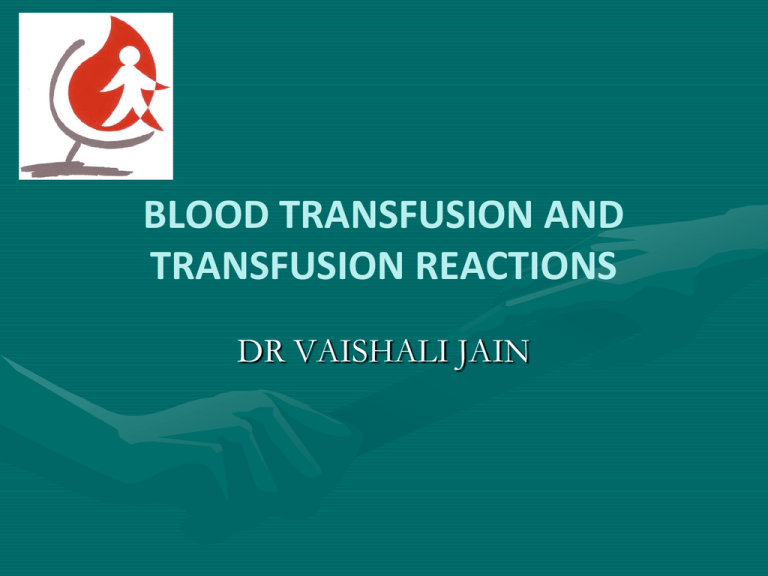
BLOOD TRANSFUSION AND TRANSFUSION REACTIONS DR VAISHALI JAIN LEARNING OUTCOMES At the end of this topic, you should able to: • Understand concept of Whole blood and blood components • Discuss types and indications of blood transfusion • Enlist tests to be performed prior to blood transfusion • Understand transfusion reactions in brief LESSON CONTENTS • • • • • Whole blood and blood components What is blood transfusion? Blood transfusion- Types, Indications Pre transfusion testing Transfusion Reactions: – – – – Classification Causes Clinical features Investigations WHOLE BLOOD AND BLOOD COMPONENTS • 350ml /450 ml of blood is collected from a donor into a plastic bag containing an anticoagulant • This is called 1 “unit” of whole blood • Whole blood can be used as it is, or is separated into “blood components” • Types of blood components:– – – – Red blood cell concentrate (packed red blood cells) Platelet concentrate Fresh frozen plasma Cryoprecipitate BLOOD COMPONENTS BLOOD TRANSFUSION Transfer of blood or blood components from one person (donor) into another person (recipient) TYPES OF BLOOD TRANSFUSION • FRESH BLOOD TRANSFUSION Blood less than 24 hours old from the time of collection • AUTOLOGOUS TRANSFUSION Blood collected from a patient for re-transfusion at a later time into the same individual • MASSIVE TRANSFUSION Number of units transfused in a 24 hours period exceeds the recipient’s blood volume • MULTIPLE TRANSFUSION Repeated transfusion of blood over a long period of time (months or year) INDICATIONS OF BLOOD TRANSFUSION • Whole Blood: – Acute blood loss – Shock – Exchange transfusion in neonate • Packed red blood cells: – Chronic severe Anemia – Leukemia – Thalassemia • Platelets concentrate: – – – – Thrombocytopenia Bleeding due to platelet dysfunction Malignancy Major surgery INDICATIONS (Contd.) • Fresh frozen plasma: – Liver disorders – DIC – Coagulation factor deficiency (V, VII) • Cryoprecipitate: – Hemophilia A – von Willebrand’s disease – Fibrinogen deficiency PRE-TRANSFUSION TESTING • ABO and Rh (D) blood grouping : – Patient’s and donor’s blood sample • Cross matching of blood sample: – Major cross match- Pt’s serum + Donor cells – Minor cross match- pt’s cells + Donor serum BLOOD GROUPING PRE-TRANSFUSION TESTING (contd.) • Screening for Transfusion transmitted diseases (Donor Sample) HIV 1 and 2 HBsAg HCV Treponema pallidum Plasmodium species AIDS Hepatitis B Hepatitis C Syphilis Malaria ADVERSE EFFECTS (TRANSFUSION REACTIONS) Immune mediated Acute Onset <24 hours Delayed Onset within days/months 1. Hemolysis Hemolysis 2. Febrile reactions Alloimmunisation 3. Allergic Post transfusion purpura 4. Anaphylaxis Graft Vs Host disease 5. TR.Ac.lung injury Immunodilution ADVERSE EFFECTS (TRANSFUSION REACTIONS) – Non-Immune mediated Acute Delayed 1. Bacterial contamination HIV 1 & 2 2. Circulatory overload Hepatitis B & C 3. Physical damage Syphilis 4. Chemical damage Malaria 5. Thermal damage Iron overload CAUSES OF TRANSFUSION REACTIONS • Clerical errors: – Inadequate labeling – Wrong blood issued • Technical errors: – Error in blood grouping & cross matching – Incorrect interpretation of test results • Others: – – – – Blood contamination during phlebotomy Blood infusion thr’ small bore needle Blood cooler to -30⁰C or warmed to > 42⁰ C Concomitant administration blood & drugs thr’ common set CLINICAL FEATURES • • • • • • • Fever : Ag-Ab cytokine IL-1 Fever Rigors: Cytokines Pain at infusion site: Cytokine Hypotension: Neuroendocrine response Hemoglobinuria Oliguria Anuria LABORATORY INVESTIGATIONS • Rule out Clerical errors: Identify blood sample • Compare plasma color on pt’s pre & post transfusion sample - Pink: free Hb red cell destruction - Yellow: increased bilirubin • Check blood color of bag & attached tubing - Purple color / clot in bag bacterial contamination - Color change hemolysis LABORATORY INVESTIGATIONS (Contd) • Repeat blood grouping on pt’s & donor sample ( Pre and post transfusion sample) • Repeat cross matching • Perform Direct antiglobulin test (DCT) • Blood smear and culture (Donor’s blood) • Others: (Post transfusion sample) – Antibody screening – Serum bilirubin – Free hemoglobin TRANSFUSION REACTION INVESTIGATION RECORD • • • • • • • • Patient’s particulars Blood bag details Regrouping results Re-cross matching results Red cell antibody screening results Urine investigations Microbiological results Signature of Technician in-charge SUMMARY • What is it? Types BLOOD TRANSFUSION Record TRANSFUSION REACTIONS Clinical features Indications Pre-transfusion testing Causes Laboratory investigations THANK YOU…



